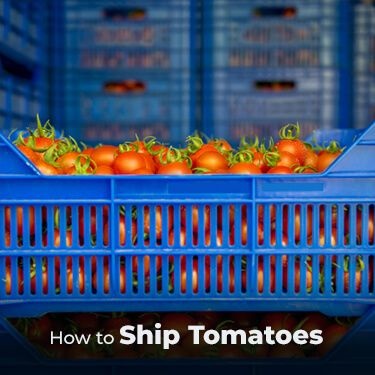
Tomatoes are one of the most popular vegetables consumed worldwide, and their transport is an important part of their production and distribution.
Tomatoes are typically transported in refrigerated trucks, cargo ships, and in some cases, aircraft. The mode of transport chosen depends on the distance being travelled and the time required for delivery. For short distances, tomatoes are usually transported in refrigerated trucks, which help to maintain the freshness of the tomatoes during transport. For longer distances, they are typically shipped via cargo ships, which can carry large quantities of tomatoes in a single shipment.
In some cases, tomatoes are also transported by air, although this is not as common due to the cost associated with air travel. In any case, tomatoes must be stored at temperatures that keep them in the best condition for as long as possible.
How to Choose Tomatoes for Transport
Choosing the right tomatoes for transport involves careful selection of fruit that is firm, unbruised, and uniformly green or partially ripened. They must be free from any visible signs of disease or pests.
1. Cold Chain Management
The transportation of tomatoes relies heavily on cold chain management, a temperature-controlled supply chain that helps maintain the quality of perishable goods. For tomatoes, the cold chain process includes pre-cooling, where tomatoes are cooled to remove field heat before transportation, and maintaining proper temperature control during transport. The use of refrigerated trucks is common in maintaining the quality and extending the shelf-life of the produce.
2. Quality Control and Inspection
Before and after transport, quality control measures are implemented. Inspectors look for the firmness of the tomatoes, skin color, and general appearance to ensure they are still in good condition. They also check the packaging for any damage that might have occurred during transport.
3. The Last Mile
The last part of tomato transportation is the “last mile” delivery, which involves transferring the tomatoes from a central hub to the final retail location. This step is critical as it can significantly affect the quality and freshness of the tomatoes.
Extra Feature: Packaging Innovation in Tomato Transport
One of the innovative features that align with tomato transport is the advent of smart packaging. This involves using materials that can monitor the condition of the tomatoes during transportation. For instance, some packaging now comes with built-in sensors that can detect changes in temperature, alerting the transport team if conditions become unfavorable for the tomatoes.
Types of Tomato Transport
Tomatoes are a versatile and delicious fruit, but getting them from farm to plate requires a reliable transport system. There are several types of tomato transport available, each with its own advantages and disadvantages.
For short distances, the most common method of transport is the ‘box truck’. These are large containers that are loaded onto trailers and driven from the farm to the processor. Box trucks are relatively inexpensive, but they are not suitable for long distances as they can easily be damaged by the elements.
For longer journeys, refrigerated trucks are the preferred option. These trucks are insulated and climate controlled, keeping the tomatoes at their optimal temperature. Refrigerated trucks are also able to traverse a greater range of terrain, making them suitable for longer trips.
Finally, air freight is the most expensive option, but it is also the fastest. Air freight is ideal for transporting tomatoes to distant markets or for delivering them to customers in a timely fashion.
Whichever type of tomato transport you choose, you can be sure that your tomatoes will arrive at their destination in peak condition.
Benefits of Tomato Transport
Tomato transport is a great way to get your tomatoes from one place to another. It is much more cost effective than other methods of transportation and can be done quickly and efficiently.
Tomato transport is also a great way to ensure that your tomatoes are kept fresh and safe during transport. With the use of temperature controlled containers, tomatoes can be transported in a healthy and safe manner.
Additionally, tomato transport makes it possible to transport large quantities of tomatoes to multiple destinations at one time. This saves time and money and reduces the risk of spoilage. Tomato transport also eliminates the need for extra packaging, which helps to reduce waste and maximize efficiency.
In short, tomato transport is an efficient and cost effective way to get your tomatoes from one place to another.

Overview of Tomato Transportation Challenges
Transporting tomatoes involves several challenges:
- Maintaining Optimal Conditions: Keeping the right temperature and humidity is crucial. Deviations can lead to spoilage and reduced shelf-life.
- Handling and Damage: Tomatoes are delicate and can easily get bruised or crushed during transportation, affecting their quality and appeal.
- Cost Constraints: The cost of special packaging, refrigerated transport, and cold storage can be high, posing challenges especially for small-scale farmers.
- Regulatory and Cross-border Issues: Compliance with different countries’ regulations when transporting across borders can be complex and may cause delays or financial losses.
- Infrastructure Limitations: Poor infrastructure, like bad roads or insufficient cold storage facilities, can impact the quality and timeliness of tomato deliveries.
To overcome these challenges, we need innovations in packaging and transportation, improved agricultural practices, better training for handlers, and enhanced infrastructure.
Regulations Regarding Tomato Transport
- Quality Standards: Tomatoes must meet certain quality standards, including size, color, and ripeness, before being transported. These regulations ensure that only healthy and safe produce reaches consumers.
- Packaging and Labeling: Regulations require that tomatoes be securely packed in containers that prevent damage during transportation. Labels should accurately describe the contents, include the country of origin, and provide tracking information.
- Temperature Control: Regulations specify that tomatoes should be transported at temperatures between 12.5°C and 15°C (55°F to 60°F) to prevent premature ripening or spoilage.
- Cross-border Regulations: When transporting tomatoes across borders, each country has its own phytosanitary requirements to prevent the introduction of pests and diseases. Compliance with these regulations is crucial to avoid delays or rejections at the border.
- Food Safety Regulations: Transporters must adhere to food safety regulations to prevent contamination during transportation. This includes maintaining clean and sanitized transportation vehicles and storage facilities.
These regulations ensure the safe and efficient transportation of tomatoes, ensuring that consumers receive high-quality, fresh produce.
FAQs About the How Are Tomatoes Transported
What methods are used to transport tomatoes?
Answer: Tomatoes can be transported by truck, rail, or ship depending on the distance they need to travel.
Are tomatoes transported in a temperature-controlled environment?
Answer: Yes, tomatoes are usually transported in temperature-controlled environments to ensure they remain fresh and in good condition.
How long can tomatoes stay in transit?
Answer: Generally, tomatoes can stay in transit for up to a week before they start to deteriorate.
Conclusion
Overall, tomatoes can be transported by truck, train, boat, and air. Each method has its advantages and disadvantages, making it important to choose the right method for the job. For example, trucks are more cost-effective and faster, but they may not be able to transport large quantities of tomatoes. Trains are slower but can carry larger quantities. Boats and planes can transport tomatoes over long distances in a short amount of time, but are more expensive. Ultimately, the choice of transportation method will depend on the specific needs of the customer.






